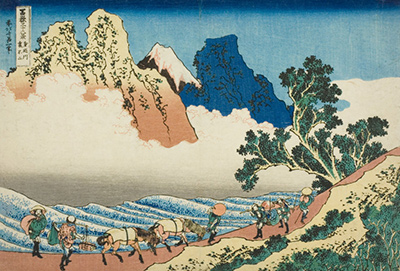Hokusai
The back of Fuji from the Minobu river by Hokusai
The back of Fuji From the Minobu River or Minobu-gawa ura Fuji is one of Katsushika Hokusai’s series of The Thirty-Six Views of Fuji or Fugaku sanjurokkei (oban Yoko-e).Hokusai depicts the travellers and horses walking run down to the Kuonji Temple, which is believed to be the head temple of Nichiren sect.
In fact, from the print some of the travellers are likely to be headed to the temple. They are all surrounded by the overlapping waves and the rugged rocky-mountains. The wave droplets are drawn with white small points that refreshes the Ukiyo-e screen. Hokusai utilizes the technique of Nishiki-e of wood print art. The entire impression of the wood block print art, which Hukosai learned when he was only six-years-old and later on at fourteen years-old as an apprentice at the bookshop and library, is used in this print to depict the dark brown of Mount Fuji.
There is a tense deep blue of the mountain next to it and the greener trees that tighten at the far end. The print that is painted on a colour woodcut medium has dimensions of 10 x 14.62 in. (25.4 x 37.1 cm), and was done between 1830 and 1831. The artwork was inspired by the ancient tradition of believing that The Mount Fuji had immortal secrets during the Edo period of 1615 to 1868 and published by a Japanese publisher Nishimura Yohachi.
Katsushika Hokusai was born in the Edo District on the 31st of October 1760 and died on May 10th 1849. He was a very gifted painter with over thirty names and well-respected amongst his peers. Since he paid close attention to the publication of his work books, Hokusai wrote two letters to the designers of his production Toshien Ehon who were blockcutters and publishers. It’s documented that he once wrote to his blockcutter that his previous blockcutter and publisher Egawa Tomekichi had strayed from his unique style of cutting certain heads, even though he respected him a lot. All this information is documented in various journals and publications of the recent years.
